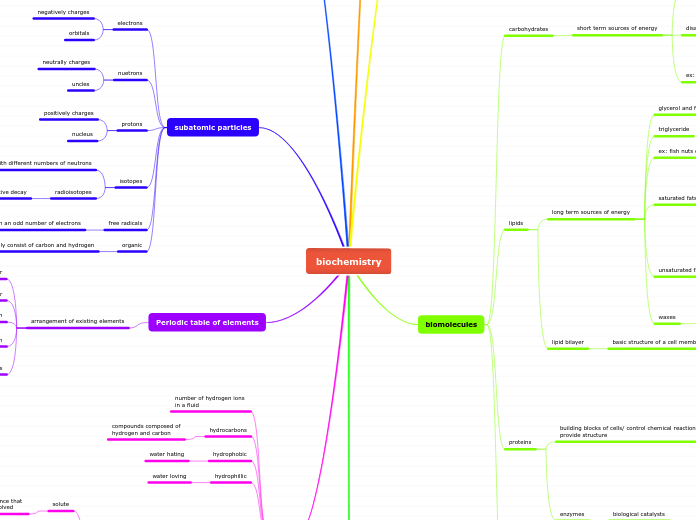
cells
the basic unit of life
homeostasis
to maintain a relatively stable internal environment
reproduction
to produce offspring
metabolism
to obtain and use energy for growth and movement
DNA/Heredity
genetic material passed on during reproduction
life needs nutrients and energy to survive
1. atoms
2. molecules
two or more atoms half together
6 ways to represent this
common name
chemical name
chemical formula
structural formula
structural model
shell model
3. organelles
4. cells
ATP
main energy for cells
5. tissue
6.organs
7. organ systems
8.organisms
9. population
community
ecosystem
biosphere
carbohydrates
short term sources of energy
monosaccharide
glucose
used during cellular respiration
disaccharide/polysaccharides
glycogen
stored in animal cells
cellulose
makes up cell wall in plant cells
starch
used for storage in plants
ex: fruits veggies and whole grain
lipids
long term sources of energy
glycerol and fatty acids
triglyceride
ex: fish nuts olives
saturated fats
solid at room temp
unhealthy fats
tightly packed
unsaturated fats
liquid at room temp
healthy fats
doublers bond between carbon atoms
waxes
water repellent forms of lipids
lipid bilayer
basic structure of a cell membrane
proteins
building blocks of cells/ control chemical reactions/
provide structure
amino acids
20 amino acid monomers
polypeptide
peptides
short chains of amino acids
ex: red mean, dairy, fish
genes
codes for proteins
denturation
when protein loses its shape and function
prion
protein particles
that cause disease
enzymes
biological catalysts
nucleic acids
carries DNA and RNA
nucleotide
DNA
instructions for making proteins
double stranded
RNA
builds proteins
single stranded
Ex: anything that was once living
science of classification
taxa
a category used in classification
consumer
eats other organisms
producer
use photosynthesis
organism
any lifeforms
species
group of organisms with exchanging genes
domain
a string of relation
trait
distinguishing characteristic
eukaryotes
cells that include nuclei
prokaryotes
single celled organism
archaea
covalent bonds
chemical bond formed when two atoms share electrons
strongest type of bond
ionic bonds
chemical bond where there is an attraction between oppositely charged ions
second strongest type of bond
hydrogen bonds
attraction between a slightly positive hydrogen atom and a slightly negative atom
surface tension
property allowing liquid to resist external force
adhesion
attraction between molecules of different substance
cohesion
an attraction between molecules of the same substance
electronegativity
a measure of the ability of an atom in a chemical
compound to attract electrons
polarity
molecules having uneven distribution of charges
evaporation
liquid to gas
weakest bond
reactions
chemical changes
electrons
negatively charges
orbitals
nuetrons
neutrally charges
uncles
protons
positively charges
nucleus
isotopes
atoms of the same element with different numbers of neutrons
radioisotopes
unstable isotopes that go through radioactive decay
radio active decay
breakdown of radioactive
element releasing particles
and energy
free radicals
chemical particles with an odd number of electrons
organic
molecules that mainly consist of carbon and hydrogen
arrangement of existing elements
mass number
protons + nuetrons
atomic number
number of protons and electrons
location
determined by atomic number of an atom
column
the same group/ they react with other elements in
similar ways
rows
the same period/ they have similar physical properties such as
how well they conduct electricity
number of hydrogen ions
in a fluid
hydrocarbons
compounds composed of
hydrogen and carbon
hydrophobic
water hating
hydrophillic
water loving
concentration
how much salute exists within
a certain volume of solvent
solute
substance that
is dissolved
solution
uniform mixture of solute
completely dissolved in
solvent
solvent
a liquid substance capable
of dissolving other substances
temperature
measure of molecular motion
acid
substance that increases the hydrogen ion concentration of a solution
base
substance that decreases the hydrogen ion concentration in a solution
buffer
seton chemicals that can keep pH of a solution stable